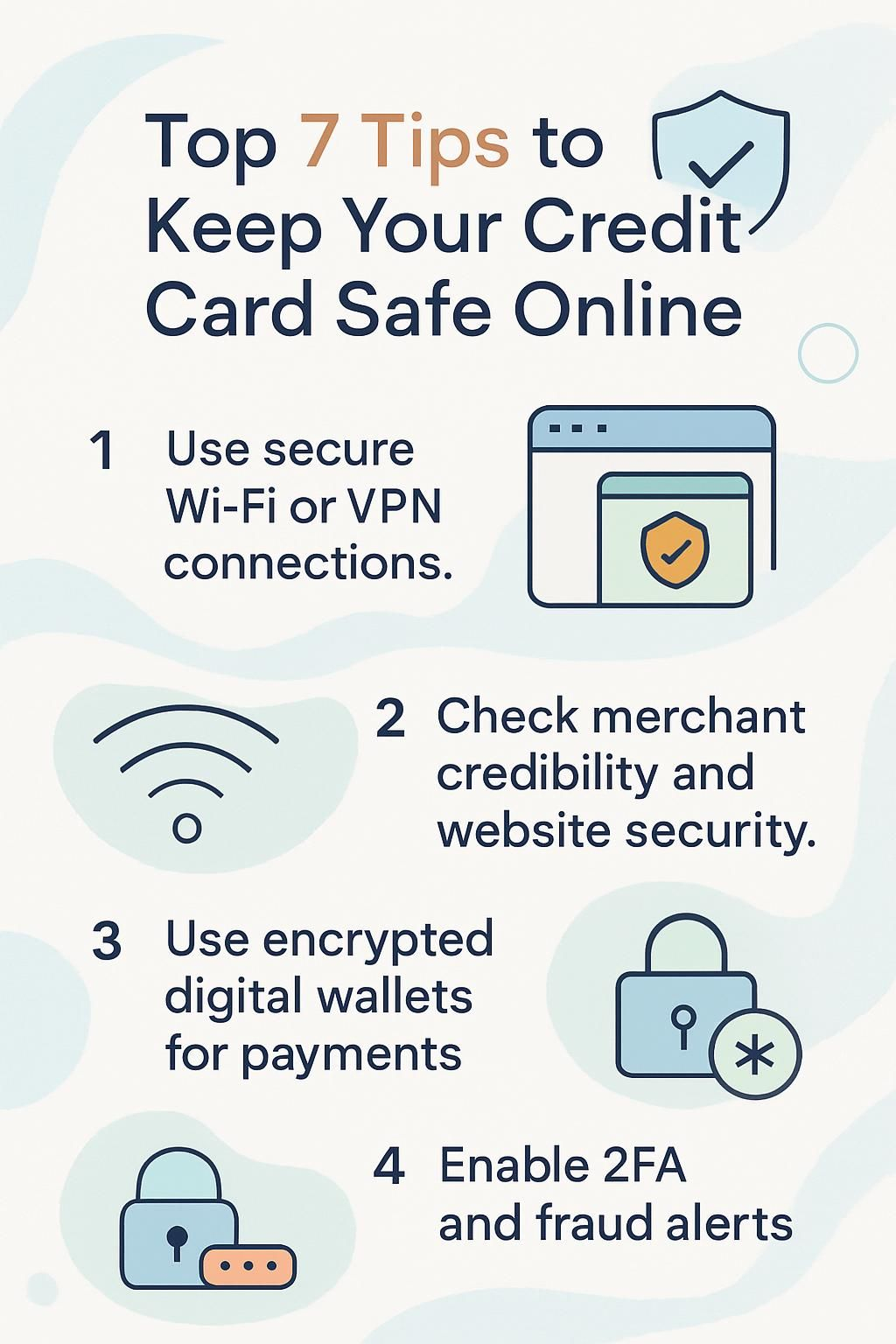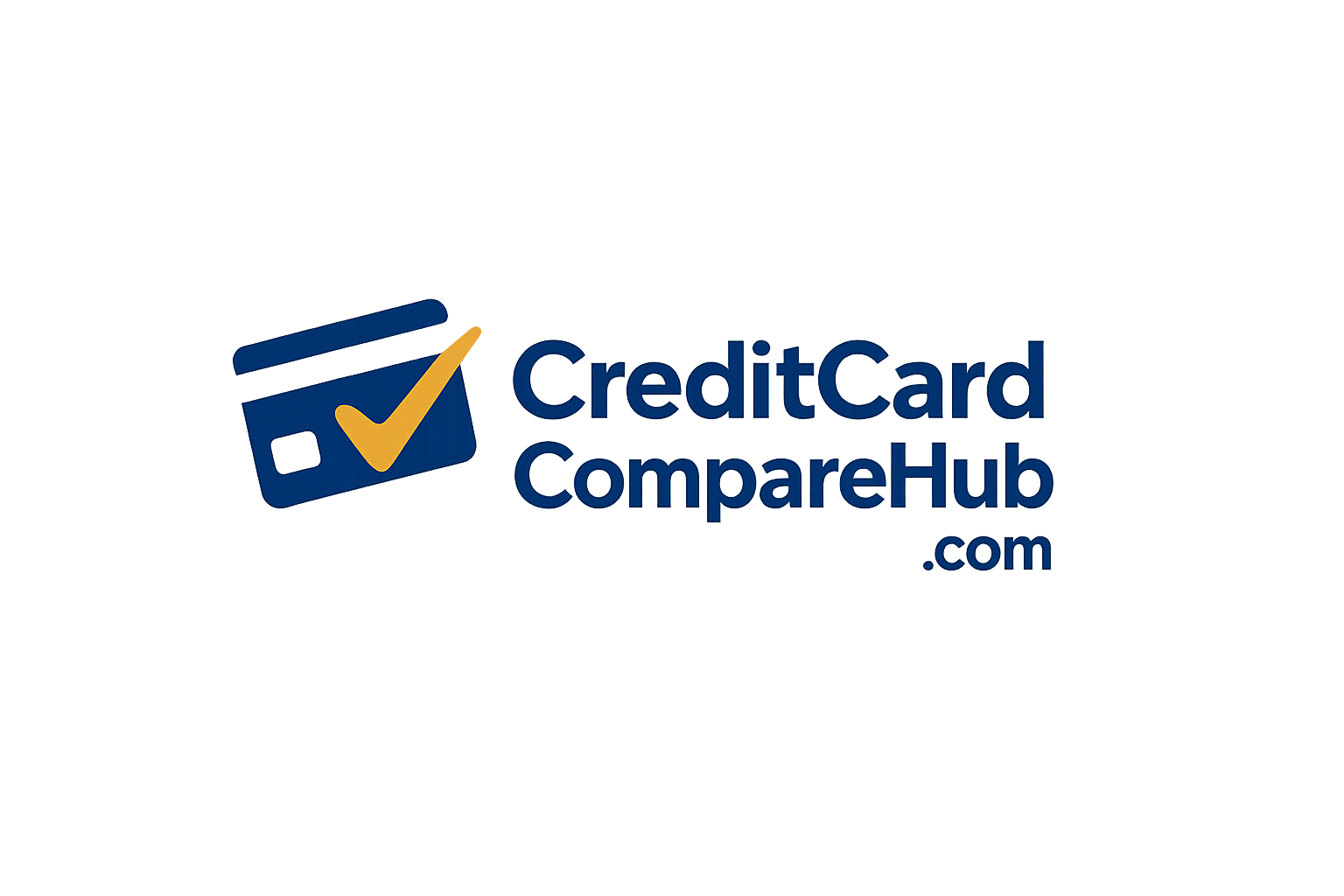Top 7 Tips to Keep Your Credit Card Safe Online
Online shopping puts your credit card at risk if you are not careful. Last year, reports of credit card fraud and identity theft reached record highs. This post will share seven smart ways to protect your payment methods like Apple Pay, Google Pay, and digital wallets when you shop online.
Read on for tips that help keep your money safe.
Key Takeaways
- Employing secure connections, such as private, encrypted Wi-Fi networks and virtual private networks (VPNs), is crucial for protecting your credit card information from hackers during online shopping.
- Verifying a merchant’s credibility through checking website security (HTTPS) and investigating their reputation via reviews or websites like the Better Business Bureau can significantly reduce the risk of fraud.
- Utilizing digital wallets like Apple Pay and Google Pay offers an additional layer of protection as these methods use data encryption and tokenization, meaning your actual credit card details are not shared with merchants.
- Activating security features provided by financial institutions, including two-factor authentication (2FA) and fraud alerts, creates an essential barrier against unauthorized access and informs you immediately of suspicious activities.
- Regularly monitoring transactions enables early detection of fraudulent charges, reducing potential financial loss. Implementing strong passwords for online accounts adds another line of defense by making unauthorized access more challenging.

Use Secure Devices and Connections

Always shop or pay bills online with your own smartphone, tablet, or laptop and keep their internet browsers up to date. Set up a virtual private network (VPN) for extra protection so hackers cannot steal your credit card details during online shopping.
Why should I avoid public Wi-Fi for online payments?
Public Wi-Fi puts your credit card information at risk. Hackers can access unsecured networks at airports, hotels, or cafes and intercept personal data you send. I once connected to free airport Wi-Fi during a layover and paid for a hotel room using my debit card.
Within hours my bank reported fraudulent activity linked to that transaction. Attackers use phishing schemes or set up fake “free” hotspots to steal passwords, social security numbers, or even record keystrokes as you type.
Encrypted private networks like your home Wi-Fi provide much safer environments for online shopping and mobile payment apps such as Apple Pay and Google Pay. Any financial activity over public connections could expose sensitive details, inviting identity theft or unauthorized charges on your accounts.
The Federal Communications Commission warns that these risks are real; millions of Americans report cases of credit card fraud every year tied back to insecure wireless connections.
Next, let’s explore how private encrypted networks help protect credit cards from cybercriminals and phished data leaks.
How do private, encrypted networks protect my credit card?
Sticking with secure connections matters after dodging public Wi-Fi during online payments. Private, encrypted networks add an extra layer of digital security for your credit card safety.
These networks use data encryption to scramble your information while it travels between your device and financial institutions like Capital One or Chase. Hackers cannot read your credit card details, social security number, passcodes, or account numbers if they intercept them because the encryption turns that data into unreadable code.
Using a trusted home router with up-to-date browser software means only devices you allow can get on your Wi-Fi network. This setup blocks outsiders from getting unauthorized access to sensitive info such as one-time codes from two-factor authentication (2FA) or alerts sent by your bank about suspicious charges.
Private internet connections give you better fraud prevention against phishing attacks and reduce the risk of identity theft that often follows a major data breach. Strong passwords and secure websites combine well with private Wi-Fi settings for complete protection during online shopping or mobile wallet payments using Apple Pay and Google Pay.
Verify the Merchant’s Credibility
Always check if the seller uses a secure website with data encryption, such as HTTPS in the address bar. Confirm their reputation through sources like the Better Business Bureau before you shop or enter your credit card information.
How can I check if a website uses HTTPS?
Scan the web address before typing your credit card information. If you see “https” at the start of the URL and a padlock icon in your browser’s address bar, that means the site uses data encryption to help protect sensitive details like social security numbers or card credentials during online shopping.
Secure websites use HTTPS to prevent hackers from intercepting your payment information on both smartphones and computers.
Major browsers such as Google Chrome and Safari highlight secure sites with a small padlock symbol next to the web link. Some also alert you if a website is unsafe or lacking proper digital certificates.
By using only HTTPS-protected sites, you reduce your exposure to phishing scams and fraudulent transactions, boosting credit card safety every time you shop online or pay bills digitally.
What’s the best way to research a seller before buying?
Check reviews on sites like Trustpilot or the Better Business Bureau before you enter credit card information. Search for complaints about fraudulent transactions, identity theft, phishing scams, or poor service.
Use Google to search the company’s name along with words like “scam” or “fake websites.” A secure website should use HTTPS and display a small padlock next to its URL in your browser.
Look up the seller’s business address and phone number; real companies provide clear contact details for customer support. Try contacting their cardmember services with questions before making a purchase.
Read policies on returns and refunds to see if they sound reasonable. If anything feels off, choose digital wallets like Apple Pay or Google Pay which offer another layer of fraud prevention during online shopping.
Leverage Digital Wallets
Digital wallets like Apple Pay and Google Pay let you pay online without exposing your credit card information. These contactless payment tools use data encryption, which helps protect against identity theft during online shopping.
What are the benefits of using Apple Pay or Google Pay?
Apple Pay and Google Pay keep your credit card information safe by using data encryption and tokenization. Your actual credit card number never reaches the merchant. These payment apps use Face ID, fingerprint scans, or a one-time code for each purchase, making unauthorized access nearly impossible.
Contactless payments reduce the chance of exposure to card skimmers since you do not need to swipe or insert a physical card.
You gain extra rewards like cash back on certain cards when paying with these platforms during online shopping. Alerts from financial institutions let you spot suspicious charges right away.
Using Apple Pay or Google Pay also means your details are protected even if there is a data breach at the store. A friend once lost his debit card at an airport lounge but made every purchase that day safely through Apple Pay; this simple switch saved him from headaches with fraudulent activity.
With Apple Pay and Google Pay, your account security travels with you wherever you go.
Enable Security Features
Enable security features like two-factor authentication, fraud alerts, and Face ID to add powerful layers of protection—your credit card company and financial institutions offer these tools for extra peace of mind, so explore how they keep your digital wallets and accounts secure.
Keep reading to see how you can lock down your information even tighter.
How do I set up fraud alerts on my credit card?
Set up fraud alerts on your credit card by logging into your account on the bank’s secure website or mobile app. Most major credit card companies, like Capital One and Chase, allow you to activate instant text alerts or email notifications for suspicious charges, fraudulent transactions, or unusual spending activity.
You can also request fraud prevention options such as one-time codes before larger purchases go through.
Contact customer service if you want added protection or prefer voice calls over digital messages. Many financial institutions offer different alert levels—customize these based on your habits and travel plans for optimal identity theft protection.
Next up, see why two-factor authentication is essential for keeping all of your accounts safe from unauthorized access.
Why is two-factor authentication important for my accounts?
Two-factor authentication, or 2FA, adds an extra line of defense to your accounts beyond just strong passwords. Hackers often steal login details through phishing scams or data breaches.
Even the best password can fall into the wrong hands. With 2FA switched on, a thief needs more than a password; they must also provide a one-time code from your phone or email before they can access your financial institutions’ websites or apps.
Financial crimes depend on speed and weak defenses; two-step verification slows cybercriminals down and stops unauthorized access fast.
I use text alerts for my American Express and Bank of America accounts, giving me instant warnings about suspicious charges that could point to attempted credit card fraud or identity theft.
Many banks offer face ID options as well as codes sent by SMS for better digital security across all platforms, including Apple Pay and Google Pay wallets. Most major brands enforce these features after massive incidents like the Capital One breach in July 2019 that exposed over 100 million credit reports and social security numbers.
Ready to strengthen other key safety measures besides 2FA? Researching merchants is next on the list for online shopping confidence.
Protect Your Account Information
Guard your credit card information by keeping passwords long and unique, using a password manager for extra digital security, and staying alert to phishing scams—discover more tips to outsmart identity theft.
Why shouldn’t I share credit card details over email or phone?
Criminals can steal your credit card information through email or phone calls in seconds. Cybercriminals use phishing scams to trick you into sharing private data, like a credit card number or social security number.
Email and phone lines are easy targets for hackers as they rarely offer strong encryption or any real identity protection. If someone intercepts your message, they might quickly make fraudulent transactions under your name.
Financial institutions always recommend using secure websites with HTTPS or encrypted digital wallets such as Apple Pay and Google Pay for sharing payment details online. Avoid giving out sensitive information to anyone who contacts you by phone, text, or email—even if the correspondence seems convincing.
Now that you know how risky it is to share this information over unsecured channels, creating strong passwords offers another layer of fraud prevention and account security.
How can I create strong, unique passwords for my accounts?
Sharing your credit card information over email or phone gives hackers a prime opportunity for identity theft, so building better password security acts as your first defense against unauthorized access.
Strong passwords should be long, use both upper and lower-case letters, numbers, and special symbols. Avoid personal info like birthdays or names that someone could easily guess from social media.
Password manager tools such as LastPass or 1Password help you create and store complex credentials without writing them down or reusing old ones across multiple accounts. Enable two-factor authentication (2FA) whenever possible; banks and financial institutions often provide this added layer using a text alert or one-time code for logging in.
This step drastically cuts the chance of fraudulent transactions by making it harder to breach accounts with only stolen passwords.
A unique password is like a lock that fits only one door—protect each account with its own key.
Monitor Your Transactions Regularly
Keep an eye on your credit card statements and use account alerts from financial institutions to spot suspicious charges early—smart monitoring makes credit card safety simple, so keep reading to discover more effective fraud prevention tips.
How do I check statements for unauthorized charges?
Checking your statements for unauthorized charges is vital for maintaining credit card security. This procedure allows early identification of fraudulent transactions, facilitating rapid intervention to halt further harm. Here are some tactics to effectively monitor your credit card statements:
- Register for electronic statements via your financial institution’s website. Digital access provides the convenience of checking your account activity anytime, making it simpler to identify inconsistencies.
- Arrange for email or text notifications for each transaction. Immediate alerts facilitate prompt awareness of unauthorized transactions, instead of waiting for your monthly statement.
- Examine each transaction in detail. Search for purchases you don’t recall or places where you haven’t shopped.
- If possible, correlate receipts with statement entries. Connecting your actual purchases to the transactions on your statement can help detect any discrepancies.
- Utilize apps supplied by credit card companies like Capital One or digital wallets such as Apple Pay and Google Pay for simplified monitoring. These services usually offer a more intuitive interface for tracking expenditure and identifying suspicious activities.
- Pay special attention to small transactions; swindlers occasionally trial with tiny amounts before making larger charges.
- Watch recurring subscriptions and automatic payments separately, confirming that these anticipated charges correspond to the terms initially agreed upon and have not unexpectedly surged.
- Instantly report unauthorized charges upon discovery to minimize liability and expedite issue resolution, typically via the number on the back of your card or through the issuer’s website.
- Refresh passwords frequently, choosing powerful, unique combinations to safeguard online access to financial accounts, making it more challenging for identity thieves to gain unauthorized access.
- Guarding extends beyond just surveillance; consistently updating software on devices used for financial transactions assures optimum security against phishing scams targeting personal information theft.
In implementing these measures, I discovered that I was able to detect unauthorized charges promptly and strengthen my digital security habits surrounding my financial accounts.
What should I do if I spot suspicious activity?
Recognizing dubious activity on your credit card can be unsettling. Responding swiftly is key to safeguarding your financial health and credit track record.
- Examine your recent transactions: Scrutinize your credit card statement for any expenses that seem unusual. At times, fraudsters experiment with smaller sums before executing larger fraudulent transactions.
- Reach out to your credit card issuer straightaway: Dial the number at the rear of your card to report any unauthorized expenses or activity. Credit card providers like Capital One have round-the-clock helplines for such emergencies.
- Modify your online passwords: Refresh the passwords for your accounts, particularly the ones linked to banking and shopping websites. Ensure these passwords are potent, using a blend of letters, numerals, and symbols to fortify security.
- Activate two-factor authentication (2FA): Supplementing an extra layer of security aids in averting unauthorized access even if someone cracks your password. With 2FA, verifying identity through methods like SMS or email alerts adds safeguarding.
- Initiate account alerts: Numerous financial establishments offer alert systems that notify you about unusual activity on your account via text or email—activating these supports early fraud detection.
- Keep tabs on your credit report: Monitor your credit score fluctuations by checking reports from principal credit reporting agencies from time to time.
- Communicate the incident to authorities if needed: For substantial identity theft beyond mere fraudulent charges, reaching out to local law enforcement or the Federal Trade Commission is recommended.
- Ponder a freeze on new credit applications: If identity theft appears expansive, freezing new inquiries on your credit report halts further damage by preventing new applications.
- Apply secure payment methods for upcoming purchases: Preferring contactless payments through digital wallets like Apple Pay or Google Pay mitigates risks as they apply data encryption and abstain from sharing actual card numbers with sellers.
Adopting these measures aids in defending against current dubious activities and also fortifies guard against potential upcoming threats to financial protection and personal data confidentiality.
How to Spot and Avoid Credit Card Fraud
Spotting credit card fraud starts with checking for suspicious charges on your statements. Watch out for small, unknown amounts first; criminals often test cards with tiny transactions before making larger moves.
Phishing scams appear as texts or emails from banks or financial institutions and usually ask you to click a link or share personal details like your social security number. Do not enter sensitive data unless the website address starts with HTTPS, which signals a secure website using strong encryption.
Two-factor authentication adds an extra layer of digital security by sending a one-time code through text alerts or email alerts whenever someone tries to log in.
Fraud prevention gets easier when you set up account alerts through services like Capital One and review all transactions frequently. Strong passwords protect against unauthorized access, while password managers help create unique login information for each account.
Chip cards and contactless cards such as Apple Pay or Google Pay provide another level of safety because they use data encryption and do not disclose your actual credit card information during payment.
Stay proactive about updates to browsers and mobile apps since cybercriminals exploit outdated software fast. Taking these steps leads naturally into keeping track of unusual activity by monitoring your transactions regularly next.
Conclusion
Protecting your credit card online takes a few smart habits. Use secure sites and update your browsers often. Set up two-factor authentication to block unauthorized access. Keep an eye on your credit card statements for any suspicious charges and act fast if you spot fraud.
These simple steps can boost your security and help keep identity theft at bay while shopping or banking online.
FAQs
1. What are some key tips for keeping my credit card safe online?
To ensure your credit card safety, use strong passwords and two-factor authentication (2FA) when shopping online. Avoid using public Wi-Fi for transactions and always make sure you’re on a secure website before entering your information.
2. How can I prevent unauthorized access to my credit card information?
Preventing unauthorized access involves various measures such as regularly updating browser security features, utilizing password managers for improved password security, and checking with the Better Business Bureau to verify the credibility of lesser-known online merchants.
3. Can digital wallets like Apple Pay or Google Pay help in preventing fraudulent transactions?
Yes, digital wallets like Apple Pay or Google Pay offer an additional layer of protection by creating a one-time code for each transaction instead of transmitting your actual card details. They also feature data encryption technologies such as Face ID that further enhance digital security.
4. How do financial institutions help protect against credit card fraud?
Financial institutions often provide services like account alerts through text or email whenever suspicious charges appear on your account. Some even offer identity theft protection services that monitor your credit report and alert you to changes in your credit history.
5. Are there any specific precautions I should take while using debit cards compared to credit cards?
When it comes to debit cards versus credit cards, be aware that debit cards lack certain protections offered by most major credit companies against fraudulent activity. Therefore, only use them on trusted sites where spear phishing is less likely to occur.
6. What steps should I take if I become a victim of identity theft or see fraudulent activity on my statement?
If you suspect identity theft or notice fraudulent activities on your statement, immediately contact your bank or card issuer so they can freeze the account and issue a new one if necessary; also consider placing a fraud alert with major reporting agencies.

 Previous Post
Previous Post Next Post
Next Post